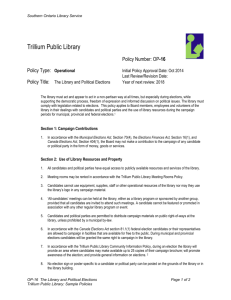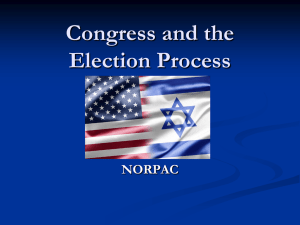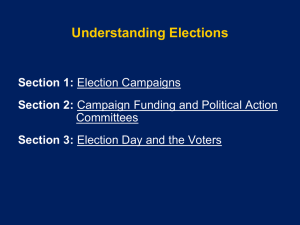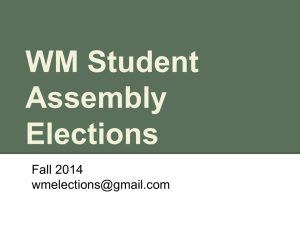CH 7 The Nominating Process
advertisement
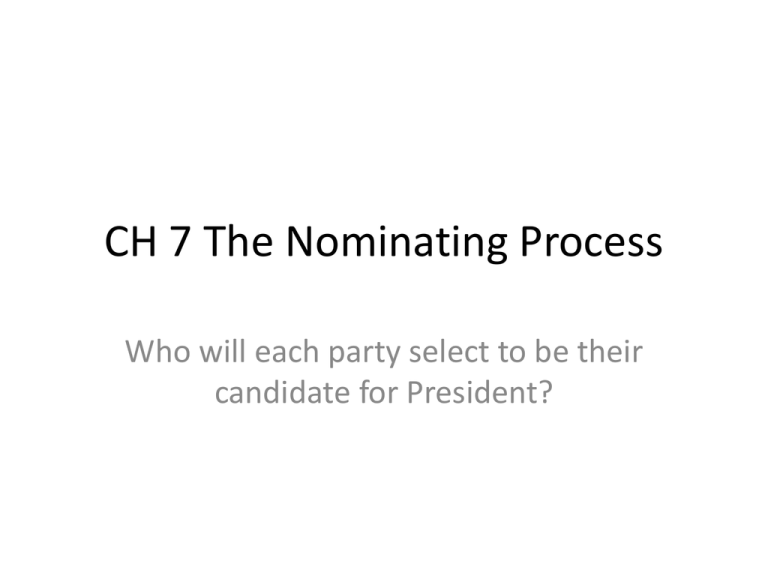
CH 7 The Nominating Process Who will each party select to be their candidate for President? Copy: • Every four years, candidates in the parties begin efforts to get their parties to select them as the candidate to run for president. • The effort begins at least a year or two ahead as they “test the political waters” and continues to about two months before the national election. • Each tries to get the most votes in various caucus and primary elections in many states. • Nomination 178 • The naming of those who will seek political office. • Caucus 180 • A group of like-minded people who meet to select candidates they will support in an election. The Primary Election • Direct primary 182 • Intra-party election • Blanket primary 183 • Any voter, regardless of party, may vote for any candidates on the ballot. The Primary Election • Runoff primary 184 • Held only if there is no clear winner of an earlier primary. • Closed primary 182 • Registered party voters may only vote for their parties’ candidates for nomination. • Copy: Some political offices are simple to run for….. • Non-partisan election • 184 candidates have no party identification. • judges Copy: • Actual elections decide who will win control of a political office. • They must be run in an honest fashion to keep credibility. • Campaigning is very expensive and needs donors. • Whether politicians are working for ordinary voters or big donors is a serious controversy today. Elections • Absentee voting • 189 registered people may vote by mail before election day Elections • Coattail effect • 190 candidates in small or weak positions get more powerful political people to speak for them or show support. • Polling place • 190 location in a precinct where people go and vote. • Ballots are collected from here and taken to a central counting location. Campaign Finance • Political Action Committee (PAC) • 197 special interests use these to support politicians and parties – Money – Advertising/”information” Campaigning • Ike • JFK • Time for some Campaigning EC: Hard money • 201 • Money raised on spent to elect candidates for Congress and the White House. • Limited and regulated by current campaign finance laws. EC: Soft money • • • • • • • • 201 Funds given to party organizations Usually for campaign purposes “party-building activities” Candidate recruitment Voter registration Get-out-the-vote drives Not limited or regulated by campaign finance laws. • A loophole that candidates take advantage of. Hwk Concepts, Class Work, to Know • Concepts: Ch 7, pp. 178-205 • EC: Why are nominations so important? (2) – 178 narrow the field down – Voters have more choices The Primary Election • Images: • 182 question • The cartoon points out the odd situation AFTER two candidates in the same party were attacking each other during the primary, and, then, the loser must say they supported the winner all the time so the party can win against the other party’s candidate. The Primary Election • Images: • 183 question • California has an open, public declaration primary system. • 184 question, • Graph suggests that voter interest has declined. • + what is the possible effect on propositions and elections? • People might not take the election seriously and not go to vote. Elections • Images: • 193 question, • Recorded information is sent to a central collection point electronically • Done from many precincts at once, as it happens. • + is this system trustworthy? Explain • Student should support with facts from text. Ballots • What different forms of ballots are there in the United States? – 191 Australian, full list, secret vote – Office-group, names listed by office, – Party-column, lists candidates by party, good for straightticket voting. – Sample, model ballots for upcoming elections, showing what real ballot will look like. – Bedsheet: a ballot so full of candidates and measures that it is difficult to make intelligent decisions. Electronic Voting • 193 Question • How are votes counted in an electronic voting system? • The voting panel sends the completed ballot to a precinct control unit; • Each precinct sends its results to a central control unit, which tallies the votes. Elections • Images • 194 question, • People might be more likely to vote if they can do it from home. • + would you vote if this was available to you? Explain. • Student response should be supported with facts from text. • BTW, it IS available in the state of California. Campaign Finance Image: – 197 question – The high cost of media coverage • TV especially. Campaign Finance • Images: – 199 question, – The growth of PACs has been a large factor in the overall increase in campaign spending. – + what information would make this graph more informative? – Student response should be supported with facts from text. Campaign Finance • Images: – 201 questions, – A hard money is given directly to campaigns. • Soft money is given and spent indirectly on things such as “voter registration drives”. – B the cartoon shows that soft money contributions are plentiful, due to a lack of government regulation, and benefit the candidates fully. – + do you think there is a need for stronger election financing regulation? Explain. – Student response should be supported with facts from text. Campaign Finance • Images: – 202 question, • • • • Individuals, families, PACs, temporary organizations. – + what kind of technology and techniques make the scene in the cartoon look antiquated? – Student response should be supported with facts from text. Campaign Finance • At what level in the election process are campaigning subsidies most important? – 196 mostly at the presidential level Campaign Finance • How did soft money create a loophole in federal election finance law? – 196 is not limited or regulated – It is not reported Nomination Process • Images: – – – – – 205 questions, 30 A the GOP and Dem candidates 30 B they have just finished fighting with other candidates from their OWN parties. – 31 It can weaken and divide the party before the general election. Elections • Do you think there would be an advantage to changing the date of elections for State officeholders from the day of national elections? Give reasons for your answer. • Advantages might be that – voters would think more carefully about the State and local candidates and issues, and that no candidates would win because of the coattail effect. • Disadvantages might be that – fewer voters would go to the polls to vote for just State and local candidates. Elections • What would be the effect on the electoral process if each precinct did not have its own polling place? • It might set an unfair limit on voting. Many voters might not be able to find transportation to distant polling places, or they might not be able to get there in time. EC: Regard the Cartoon: what do you see? EC: Campaign Finance Fairness • • • • How are the candidates portrayed? As pigs greedily eating (taking the funds) Who is feeding them? The US Treasury under the Campaign Finance “Matching Funds” program aimed at giving poorer candidates money needed to compete against richer ones. • What is the cynicism behind the man’s statement? • This government program is getting increasingly expensive, but the candidates promise to cut government spending. Campaign Finance • How do soft money and hard money differ? – – – – – – 196 soft money is given to political organizations for Party building activities Voter registration It is not regulated Hard money is given directly to political campaigns It is regulated by the FEC Quick Response: • Is money used for campaign finance (political donations) “free speech”? Explain your answer.




